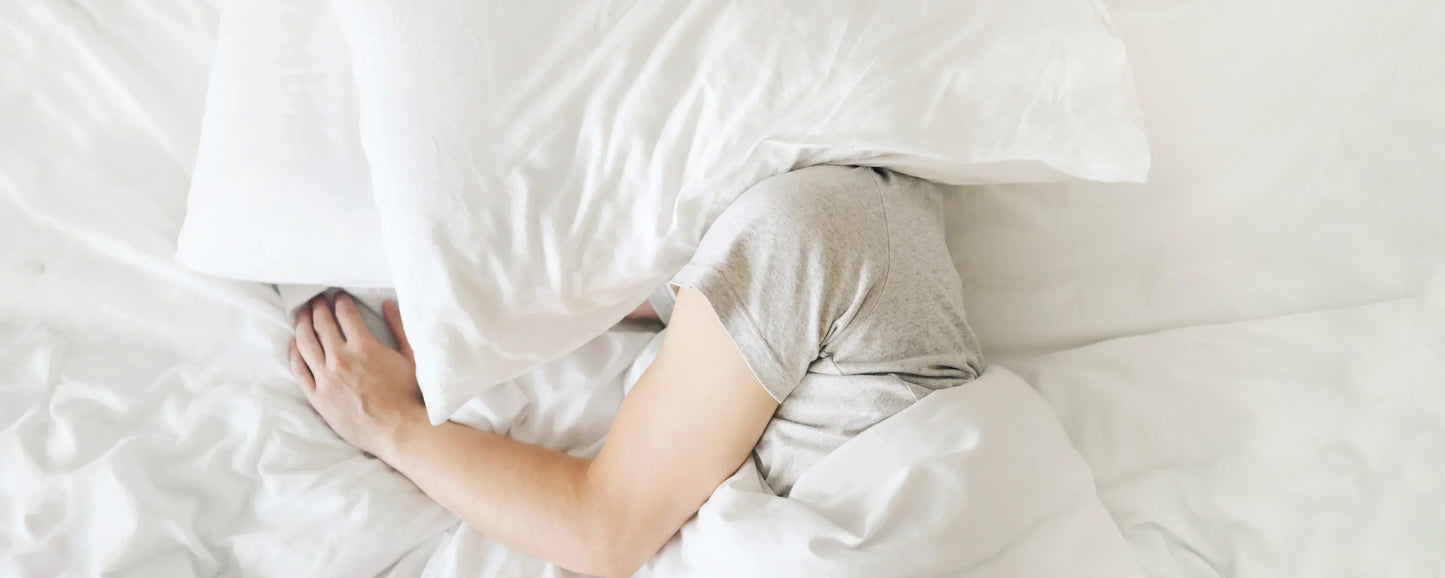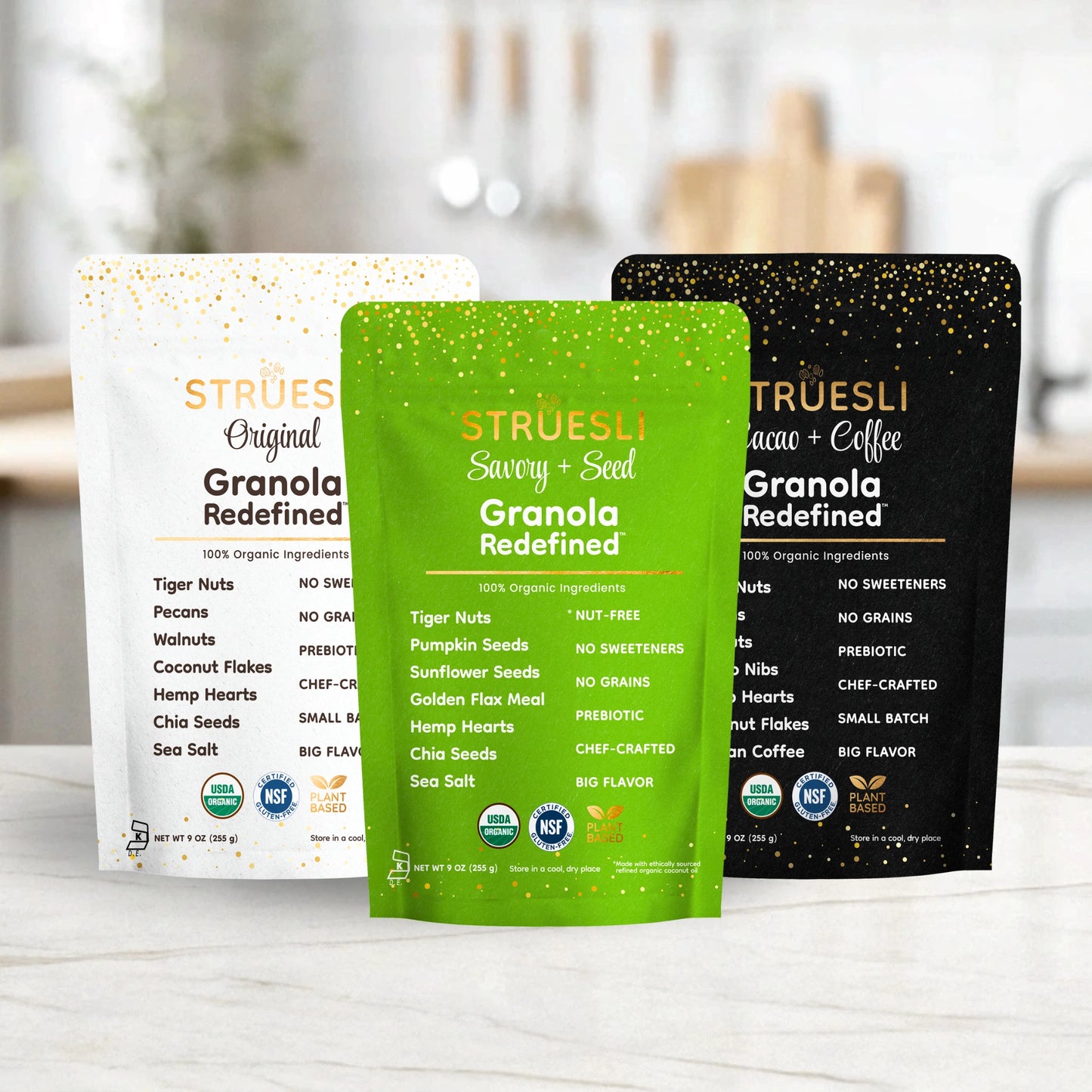
Struesli’s founder, Adrienne, knows more about migraines than she’d like to. That’s because she has been managing chronic migraines since her childhood. As a child, teen, and young adult, migraines affected everything Adrienne did, from hanging out with her friends to travel. Over time, and with the help of migraine-expert neurologists, Adrienne learned more about her triggers and how to manage a migraine when she got one.
Later on, Adrienne combined her culinary training with what she had learned about managing migraines to create meals for herself and others that were nutritious and effective. And that’s how Struesli Granola Redefined was born.
Adrienne was looking for a granola that didn’t have excessive added sugars, artificial sugars, or other zero-calorie sweeteners (all of which are commonly listed migraine trigger foods). When she couldn’t find one, she created it herself.
At a recent visit to her neurologist’s office, Adrienne took the opportunity to interview her own physician, Bridget Mueller, M.D. Ph.D. who is the Research Director of the David S. and Ruth L. Gottesman Center for Headache Treatment and Translational Research at the Icahn School of Medicine at Mount Sinai (ISMMS). Here’s what Adrienne, Dr. Mueller, and Struesli’s resident dietitian, Jessie Shafer, R.D., have to share about migraines, triggers, what to eat, and what to avoid.
Migraine Trigger Foods And Drinks
As a young adult, Adrienne figured out quickly that alcohol was a trigger for her migraines. So she abstained and was always the designated driver for her friends. And she’s not alone. In fact, alcohol is the most common listed trigger for migraine sufferers.
But since there are very few scientific studies looking at the effect of foods and drinks on people living with migraines, nearly all data on migraines is collected through surveys. While these types of surveys reveal some common trigger foods among migraine sufferers, they don’t actually prove causation. “There’s actually a lot of debate in the field,” explais Dr. Mueller, “about whether certain foods are triggers or if it’s actually a migraine already in progress.”
Some experts believe that a migraine starts several hours or even days before an attack, which is known as the prodrome phase (or premonitory phase). During this phase, someone may not know they are having a migraine yet, but may crave a certain food (such as chocolate) or partake in a certain activity (such as swimming). Later on, when the migraine becomes extremely painful and debilitating, they’ll associate the food, activity, or event with the migraine attack, even though it is likely not the root cause.
Yet still, we can learn from similarities among the foods and drinks that are often listed as migraine triggers for people. Those are:
- Foods with aspartame: This zero-calorie artificial sweetener, along with other chemical-derived sweeteners, including sucralose, Ace-K, and saccharin often show up on migraine trigger lists. Migraine sufferers tend to also be sensitive to natural sweeteners, including stevia, monkfruit, and sugar alcohols like xylitol.
- High sugar foods: Sugar is often listed as a migraine trigger, but more than the type or amount of sugar in a food, it’s really blood sugar fluctuations (big highs and/or lows in blood glucose) that is the culprit (more on that in a bit).
- Foods high in nitrates and nitrites: These include processed meats like bacon, hot dogs and sausages, deli meats, cured meats like corned beef, and some leafy greens.
- Caffeine: For sensitive individuals, caffeine in coffee or other drinks, can exacerbate a migraine. But for others, caffeine can be a relief or part of migraine therapy. Dr. Mueller counsels her patients to be consistent with their caffeine intake, meaning coffee drinkers should not randomly skip or increase their normal coffee intake. “A limit of 200 milligrams of caffeine, which is the amount in one tall Starbucks coffee or two home-brewed cups, is a safe amount for most people who get migraines and also love their daily coffee,” says Dr. Mueller.
- Foods high in tyramine: Foods with this amino acid include aged cheeses, yogurt, nuts, beans, bananas, and citrus fruits.
- Drinks and foods high in sulfites: These include processed meats like bacon, salami, as well as wine and beer, dried fruits, and pickled foods.
Other Triggers
It’s not only foods that can affect migraine sufferers. Dehydration, stress, weather changes, and sensory overload are often listed as triggers. Some other non-food triggers include:
- Big blood sugar fluctuations: Your blood sugar fluctuates throughout the day, which is a normal response to eating foods, movement, and other activities. But a big issue for people with migraines is the more extreme blood sugar spikes and lows. These can be caused by certain foods, especially high intakes of high-sugar, low-fiber foods, such as sweets and sugary drinks. Dr. Mueller is especially cautious of sugar substitutes for two reasons: “First, they interfere with the balance between good and bad bacteria in the gut, which can be a reason that migraine sufferers have more nausea and discomfort during and between migraines. Second, they change someone’s sensitivity to insulin. There’s a lot of research on insulin sensitivity in people with migraines, and fake sugar substitutes have been shown to impair our ability to respond to glucose.” It should be noted that extreme blood sugar fluctuations also can be caused by exercise, stress, sickness, and even taking certain medications.
- Hormonal changes: Migraine sufferers, especially women, may be especially susceptible to fluctuations in hormone ranges, which are affected by age, diet, perimenopause, menstruation cycles, exercise, and sleep.
- Sleep disturbances: Inconsistent sleep - either too little or too much - can be a migraine trigger for sufferers. Having poor sleep patterns also has the double whammy of affecting hormones, as well as diet. For example, there is a link between sleep deprivation and increased sugar cravings.
- Smoke and strong smells: Adrienne will attest that foods with a strong odor, such as blue cheese or truffles, affect her migraines in a negative way. Cigarette smoke, strong perfumes, gasoline, and cleaning products can also be triggers for some people with migraines.
What To Eat
Someone who is suffering from a migraine rarely feels like eating anything until they are on the other side of an episode. But there are several nutrients that can be helpful for someone who may recognize they are in the early stages of a migraine or someone coming out of a migraine. Those include:
- Foods rich in magnesium and potassium: These two electrolyte minerals are helpful for regulating blood vessels, neurotransmitters, and acute inflammation. Foods rich in magnesium include leafy greens, nuts and seeds, and beans. Foods rich in potassium are fruits, especially bananas and figs, oranges, spinach, and sweet potatoes.
- Complex carbohydrates: These carbohydrate foods are “complex” because they contain fiber and therefore take longer to digest. Foods like whole grains, oats, vegetables, beans, and lentils. Struesli Original, for example, which has a base of tiger nuts (a nutritious root vegetable) contains 5 grams of fiber per serving. The fiber helps prevent these foods from causing drastic blood sugar fluctuations.
- Omega-3s: Omega-3 fatty acids are a type of good-for-you fat found in olive oil, olives, avocado oil, avocados, and fatty fish like salmon, mackerel, halibut, and tuna, as well as flaxseeds, chia seeds, hemp hearts, and walnuts. Diets rich in omega-3s may help reduce the frequency and pain intensity of migraines.
Dr. Mueller explains that migraines are related to inflammation, both chronic and acute. So, for most people, a low-inflammation eating plan is helpful for managing migraines, especially prioritizing these eight anti-inflammatory foods in between episodes.
What To Do When A Migraine Happens
When a migraine happens, Dr. Mueller say it’s most important to treat early. That means hydrating quickly and getting some rest asap. She also says that any foods eaten when someone feels a migraine coming on, especially if caught early, should be complex carbs since they can help stabilize blood sugar.
Also, notes Dr. Mueller, “There can be gastroparesis [the slowing down of digestion] during and following a migraine, so it’s best to avoid highly processed and fatty foods for 24 hours following a migraine.”
“Resting is critical to feeling fully ourselves faster,” says Dr. Mueller. “When we don’t allow our brain and body to recover fully, we are setting ourselves up for the next migraine. So view resting as an investment: You will spend less time overall in bed if you take the time to fully recover from a migraine.”
Finding Help For Migraines
Adrienne feels fortunate to have Dr. Mueller, a neurologist who specializes in migraines and migraine treatment, in her corner. But, unfortunately, not all migraine sufferers have that kind of expert on their care team.
In America alone, between 45 and 55 million people suffer from migraines. Research indicates that 3,700 headache medicine specialists are needed to care for a population like that, yet only an estimated 564 to 750 headache specialists are certified by the United Council for Neurologic Subspecialties (UCNS).
If your migraines are “episodic” (headache days are fewer than 15 days of the month), a neurologist or even primary care provider might be able to treat your headaches adequately. However, specialty training is needed for the administration of botulinum toxin, one of the few headache treatments specifically for the treatment of chronic migraine (headaches occurring on 15 or more days of the month).
For those trying to manage chronic migraines, Dr. Mueller advises to start by consulting your primary care provider and requesting a referral to a neurologist with a specialty in headache medicine.
Alternatively, you can find a provider through several excellent organizations:
- American Migraine Foundation: Offers a Find-a-Doctor tool to locate headache specialists, migraine specialists, and neurologists.
- National Headache Foundation: Provides a Healthcare Provider Finder with information on certified headache healthcare practitioners, including those with UCNS (United Council for Neurologic Subspecialties) certification in Headache Medicine.
- UCNS Diplomate Directory: Lists board-certified headache specialists, ensuring you find someone with verified expertise.
We would like to thank Dr. Mueller for the time and expertise she lent to making this article possible.

Struesli founder, Adrienne Lufkin, and her neurologist, Dr. Bridget Mueller
_____________________________________________________________
Q&A With A Neurologist
_____________________________________________________________
Written by Jessie Shafer, RDN, a registered dietitian and nutrition consultant for Struesli. Jessie is a former magazine editor and long-time journalist who loves to turn the science of nutrition into relatable tips that can inspire and improve health from the inside out.
June 24, 2025




